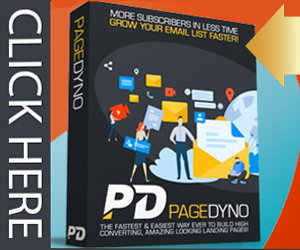‘Boring Is Better’ by Edwin Huertas
Clayton Makepeace has released the latest issue of ‘Total Package’. The featured article by Edwin Huertas is titled “Boring Is Better”. [Article]
Clayton Makepeace has released the latest issue of ‘Total Package’.
The featured article:
Boring Is Better
by Edwin Huertas
Recently, we re-designed the Early to Rise (ETR) newsletter. It looks quite a bit different these days …
Some might even say it looks “boring.”
But we say “Boring is better!”
Some of the more “exciting” features of our e-mails were preventing them from reaching our subscribers. (Maybe even you!) So we’ve made a few changes to ETR – to make sure you get it in your inbox every morning.
And by making your own e-mails more “boring,” you could see more subscribers receiving and opening them. Which, in the end, should result in more sales.
You see, the most important thing about an e-mail newsletter is not how “pretty” it looks or how “flashy” the design is. The most important thing is the content. The innovative ideas and useful techniques that made readers subscribe in the first place.
And if a newsletter’s subscribers can’t access that content because the graphics are too “high-tech,” there’s no point in sending it out at all.
Every time you send an e-mail to your subscribers, their e-mail service checks to make sure it meets their deliverability standards. E-mail policies for Internet service providers (ISPs) change more often than you can keep up with. But if you follow a few basic guidelines, you should be able to get your e-mails to nearly all of your subscribers all of the time.
I’ll outline some of the more important guidelines below, but I’d like to discuss the design of your newsletter first.
I’ve managed well over 100 e-mail marketing campaigns for various companies around the world – and it seems to me that most businesses are more interested in designing a snappy-looking e-mail than in making sure the e-mail actually gets read.
Think of it this way: Your readers didn’t subscribe to your newsletter because it’s pretty. And once they have been duly impressed by the design of your first e-mail, do you really think they care about the design of your second e-mail? NO! They simply want the content they know the e-mail can provide. The design has nothing to do with the information they want and need.
In my experience, newsletters that focus on content rather than design experience higher sales conversion rates than newsletters with heavy HTML and graphics.
The more HTML and graphics you add, the more you take away from the message you’re trying to relay. As a result, I’ve found that newsletters willing to go lighter on HTML and graphics have higher open rates.
Now you might be thinking to yourself, “Why would this change my open rates?” I don’t have enough space to give you a complete answer to that question. But here – in brief – are a few of the main reasons (based on theories I’ve tested and know to be true):
Most SPAM protection software utilized by ISPs makes use of predetermined scoring mechanisms that look for e-mails that are bloated with HTML and graphics to determine if they are SPAM. SPAM Assassin, for instance, will penalize your e-mail if it has more than 30-40 percent HTML (vs. text).
Graphics do not always display correctly in e-mails. Plus, HTML standards are always changing. So the techniques you used to design your e-mails last year might not be as effective this year.
People do NOT prefer heavy HTML and graphics in their e-mails. E-mails that are graphics/HTML-heavy can take much longer to download.
Most e-mail software (and most e-mail services like Gmail and Yahoo) blocks images by default. This is a built-in security precaution. In order for the recipient to view the graphics, they have to click on a button or link to allow it. (And why would you want to make a customer click anything just so they can read your e-mail properly?)
Many of the companies I’ve helped in the past had the idea that, in order to make the most of their (virtual) real estate, they should leave no white space in their e-mails. But I’ve found that most people react much better to e-newsletters (and Web pages) that are “clean” looking, with plenty of white space.
Leaving the right amount of white space allows your viewer to read your e-mail more easily. (They can target the specific sections they’re interested in.) This gives them a better overall usability experience and makes it more likely that they’ll continue to open and read your e-mails.
ETR’s CEO and Publisher, MaryEllen Tribby, said, “I don’t care how “pretty” our readers think it is – I just want to make sure they get our valuable content every day.”
Keep her words – and my guidelines – in mind when you send out your own e-mails. Sure, graphics, colors, and HTML can make an e-newsletter look slick and professional, fancy and fun. But they can also trigger your subscribers’ spam filters and cause other problems with deliverability and readability that you just don’t need.
Keep it simple. You could increase your open rates – which could skyrocket your sales.
Contributed by Edwin Huertas
Guest Contributor
THE TOTAL PACKAGE
Edwin Huertas is Search Engine Marketing Specialist for Early to Rise (www.EarlytoRise.com). Early to Rise is a free, daily, online newsletter full of useful ideas about marketing, business building, investing, natural health, and much more. Click here to sign up for this unmatched free resource, and learn new ways every day to make yourself healthier, wealthier, and wiser.
Attribution Statement: This article was first published in The Total Package. To sign-up to receive your own FREE subscription to The Total Package and claim four FREE money making e-books go to www.makepeacetotalpackage.com.
The Total Package
*IMNewsWatch would like to thank Clayton Makepeace for granting permission to reprint this article.
Comments are closed.

